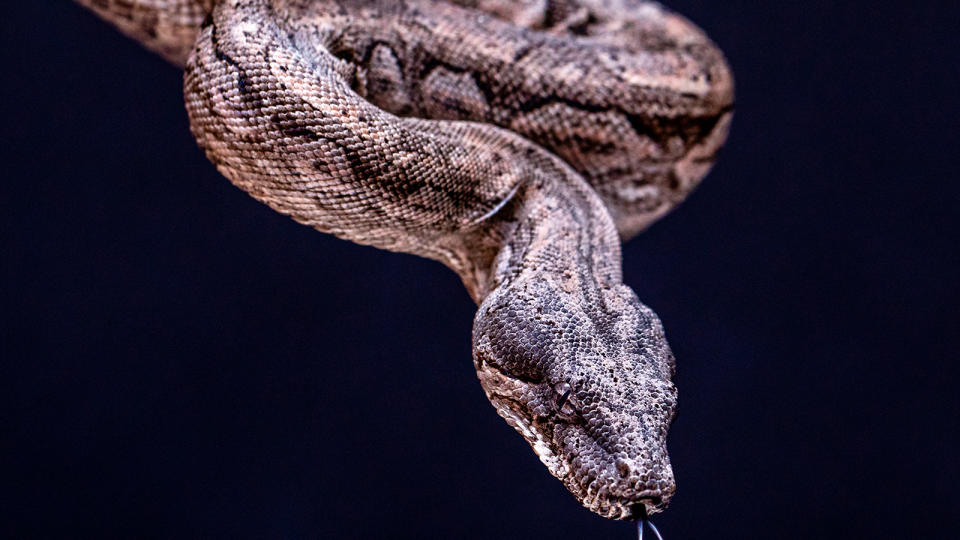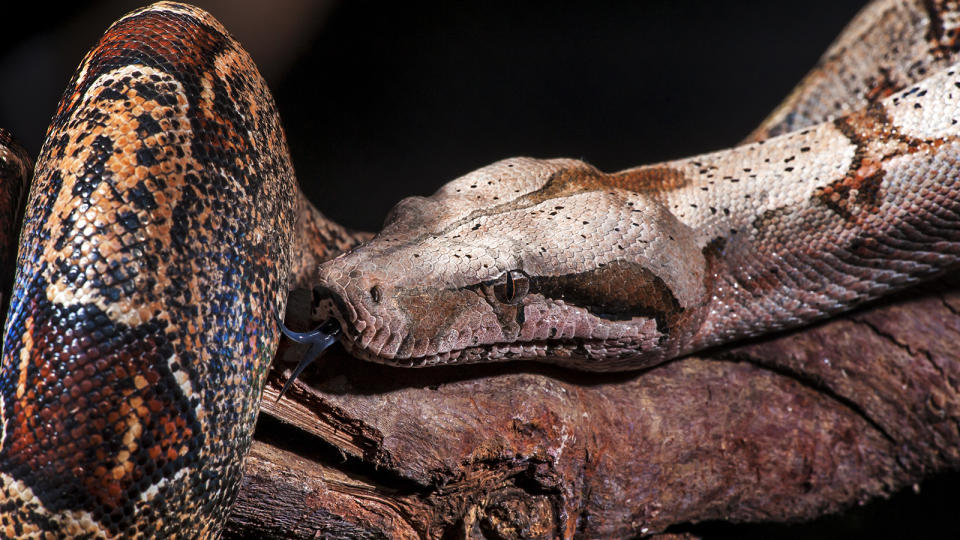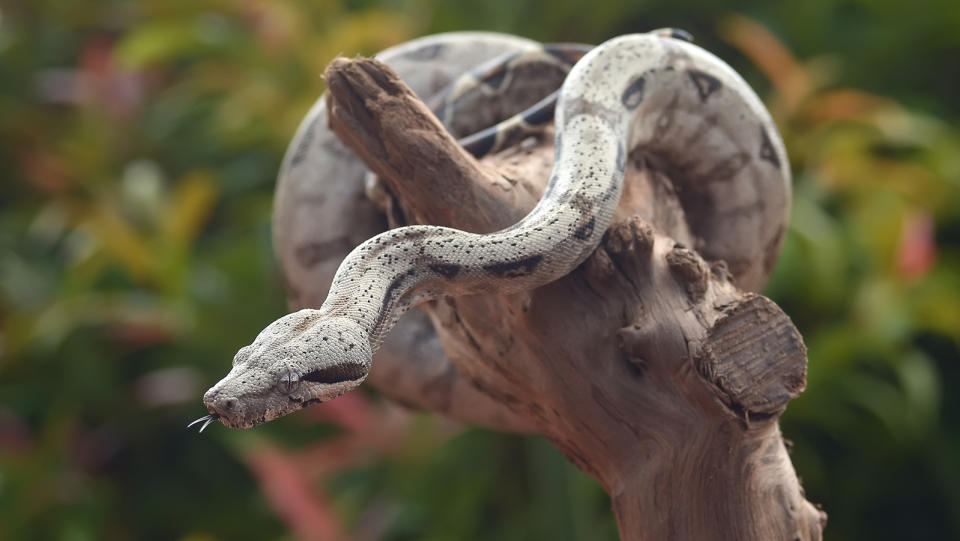4 Boa Snake Subspecies and the Constrictor Pet Trade
The boa snake captivates reptile enthusiasts and researchers alike with its size, behavior and unique adaptations. Native to Central and South America, the large and heavy-bodied snake occupies a wide variety of habitats, from rainforests to arid regions.
Learn more about this nonvenomous snake, including why it's one of the most iconic species in the pet trade, and the crucial role it plays in maintaining rodent populations and other prey species throughout ecosystems.
Physical Characteristics
Boa constrictors feature a muscular build and can grow to weigh more than 100 pounds (45 kg) and be more than 10 feet (3 meters) in length. They typically reach lengths between 6 and 10 feet (1.8 to 3), though some individuals may grow larger.
The coloration of a common boa varies, with a background of brown, gray or cream, marked by dark, saddle-shaped patterns along its back. The tail often exhibits reddish-brown tones, giving rise to the term "red-tailed boa" for certain subspecies.
Boas also possess pelvic spurs — small vestigial limbs near the base of the tail — a remnant of their evolutionary past. Their eyes have vertical pupils, suited for their nocturnal lifestyle.
4 Boa Subspecies
Boa constrictors are members of the scientific family Boidae. Scientists have identified several boa subspecies, each with distinct characteristics.
1. Boa Imperator

The Boa constrictor imperator, which commonly lives in northern Mexico and Central America, is tan with dark brown markings.
2. Argentine Boa

The Boa constrictor occidentalis, native to South America, tends to reside in the Andes Mountains. B. occidentalis boasts dark spots on a grayish background.
3. Red-tailed Boa

Boa constrictor ortonii, another popular species, is easy to distinguish from other boas due to its vibrant tail coloration. Red-tailed boas are a frequent sight in captivity, though their wild populations are under increasing pressure due to habitat destruction and collection for the pet trade.
4. Short-tailed Boa

Among the less-known species is the Boa constrictor amarali (also known as the short-tailed boa), which resides in Bolivia and Brazil and features a more compact body compared to other boa species. This subspecies inhabits tropical and desert environments alike, showing how boa species have adapted to varying ecological niches.
Boa Constrictors as Predators
Boas are ambush predators, meaning they lie in wait for their suitable prey, which can range from small mammals like rats to medium-sized mammals and even birds.
Their diet consists of a variety of other animals, depending on the size of the snake and the environment. Large snakes, such as mature boa constrictors, can take down substantial prey, including other snakes and large meal options like pigs.
Boa constrictors get their name from their method of killing prey. They wrap their strong, muscular bodies around their prey and squeeze until the prey can no longer breathe. The snake then swallows the prey whole, relying on its slow metabolism to digest its meal.
In the wild, boas are vital for controlling rodent populations, and in ecosystems across Central America and South America, they contribute significantly to maintaining ecological balance.
Reproduction and Lifecycle
During boa constrictors' breeding season, several males may compete for multiple females. After mating concludes, the embryos remain in the mother's body until they are ready to be born.
Boas are viviparous, meaning that after the gestation period, females give birth to live young instead of laying eggs like many other snakes, including pythons. The female boa’s body provides warmth during the pregnancy, and the young boas emerge fully developed.
Young boa constrictors are typically independent shortly after birth, starting to hunt for small prey. Sexual dimorphism is common in boas, with females typically growing larger than males.
This reproductive strategy, along with their hardy nature, contributes to their survival success as a species.
Captive Breeding and the Pet Trade
Captive boas are popular in the pet trade due to their striking appearance and the relative ease of care compared to more demanding snakes, such as pythons. Enthusiasts breed captive boa constrictors, including the rainbow boa (Epicrates cenchria), for their unique color morphs, further boosting their appeal.
Captive-bred boas typically have a relatively peaceful disposition, making them suitable for experienced snake keepers. However, the success of their care depends on your ability to re-create the right environmental conditions, including controlling their body temperature and offering appropriate prey like rats and small mammals.
Threats to the Species
While some species of boas are common, others, such as B. occidentalis, face a more uncertain future. Threats such as habitat destruction, over-collection and the illegal pet trade have severely impacted wild populations.
Conservation efforts aim to protect these extremely rare species and restore their natural habitats. Appendix II of the Convention on International Trade in Endangered Species (CITES) lists boa constrictors, regulating their trade.
In contrast, some boas, like tree boas and the rubber boa, have managed to thrive in specific niches, from climbing trees to living in underground burrows. These boas have evolved unique adaptations, showcasing the incredible diversity within the boa family and their ability to survive even in changing environments.
Boas and Interactions With Humans
Boas sometimes make headlines outside their native range. For instance, boa constrictors are not native to the state of Florida; however, escaped or released boas, alongside pythons, have established themselves in the wild, becoming an invasive species.
The Florida Fish and Wildlife Conservation Commission continues to manage and control boa constrictor populations to mitigate their impact on local ecosystems.
We created this article in conjunction with AI technology, then made sure it was edited and fact-checked by a HowStuffWorks editor.
Original article: 4 Boa Snake Subspecies and the Constrictor Pet Trade
Copyright © 2024 HowStuffWorks, a division of InfoSpace Holdings, LLC, a System1 Company


